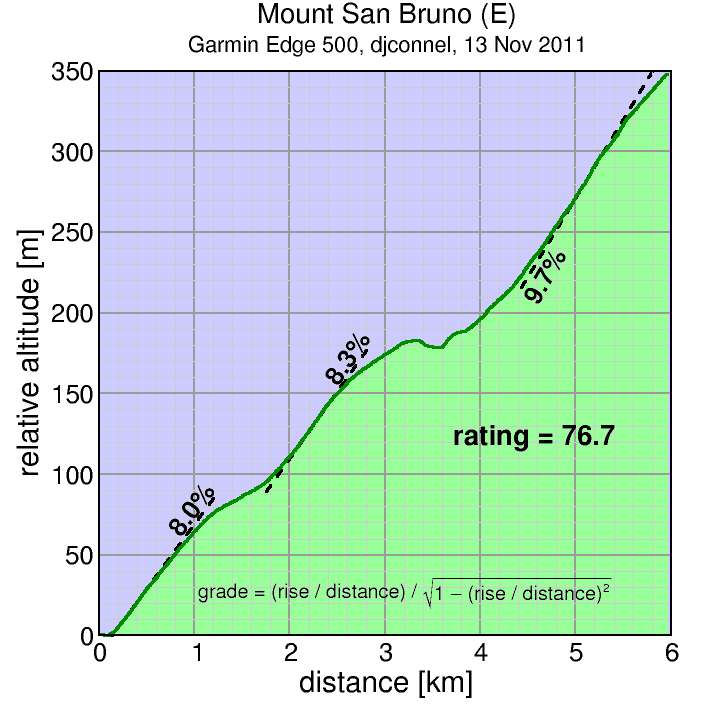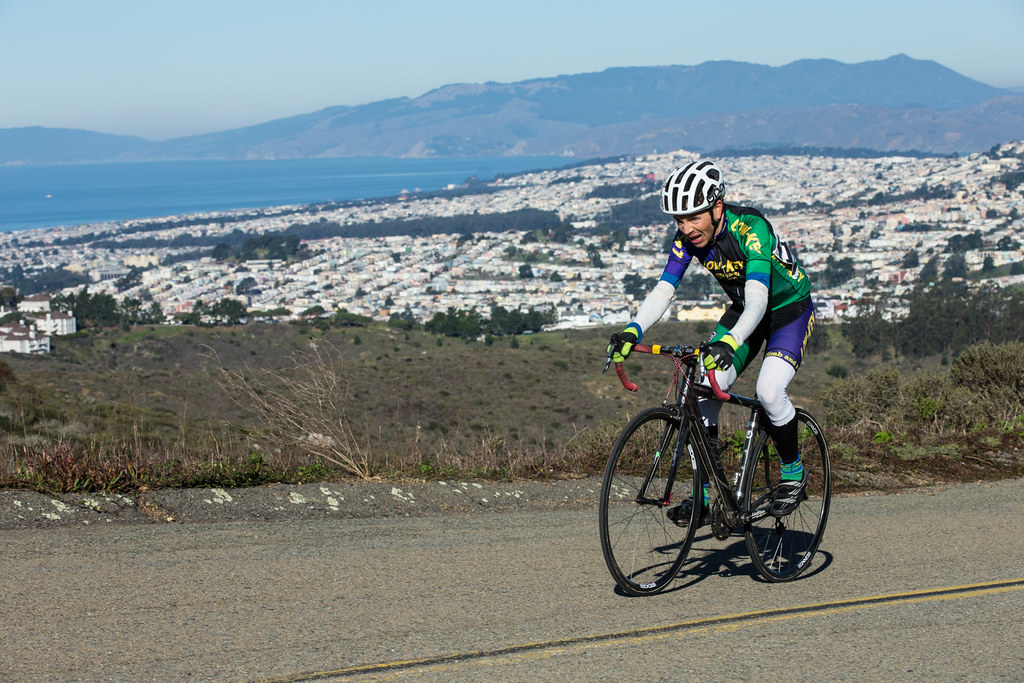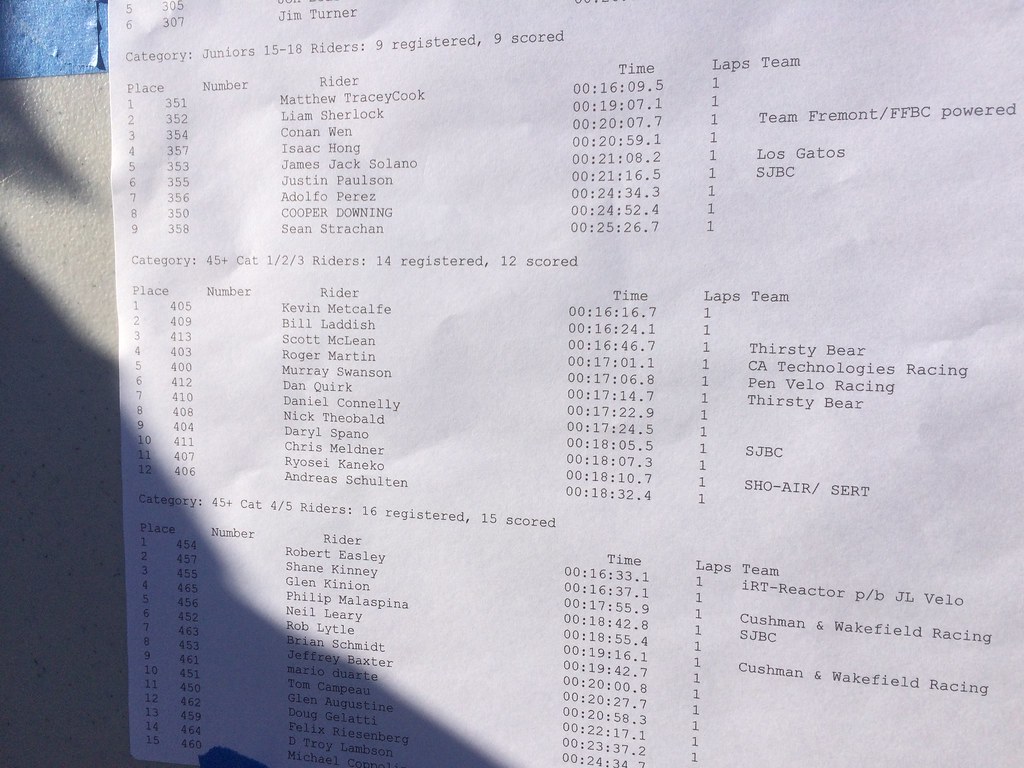San Bruno Hill Climb 2015: report
After the 2014 Low-Key Hillclimbs came to a successful conclusion thoughts naturally turn to the San Bruno Hillclimb which comes five weeks later. I'd ridden fairly well at the Low-Key series. After running my first ever 50 km trail race at the Woodside Ramble in April, it had been a decidedly down summer for me fitness-wise, neither doing any running races, bike races, or any endurance rides of note, with the single exception of the Memorial Day Ride (4 days from San Jose to Santa Barbara). I was really in a rut, sort of treading water without making any progress.
But spending all of September and the first 12 days of October based in Basel, Switzerland gave a nice boost to my training load. The first two weeks weren't much, and indeed the entire second week was spent working without much training, but weeks three through six were a solid mix of long bike rides and decent runs. This gave me a bit of a cram course in base which had me feeling better on the bike than I had all year.
Coming back to San Francisco, though, the European experience had remarkably little effect on my Old La Honda times during the few Wednesday Noon Rides I was able to attend. That was a bit of a mystery to me, since I felt that surely all the volume and a bit of welcomed weight loss that came with it should have helped. But I didn't see it in the numbers.
Still, I was able to carry a larger training load out of Europe than I did going into it, and so that had to be a good thing.
My first Low-Key Hillclimb should have been week 3, Welch Creek, but I missed that due to recovery from oral surgery. Week 4 was a short-hill ride which was good training but not really to my strength, which is longer, steady-state climbing. Week 5 Felter Road, which went fairly well, but with its highly variable grade was a road which tended to favor the power climbers. Week 6 was Umunhum, and that went very well. Week 7, was coordinated by Cara and I and so I didn't ride. Week 8 was dirt, never my strength. Then week 9, Mount Hamilton, went fairly well for me, but not as well as I've done at my best.
All in all, though, the competitive climbing should have put me in a good position for New Years. But six weeks is a long gap to span. I was at IEDM in San Francisco for 3 days, then traveled to the East Coast for 6. I was able to get some decent running in, however, on the East Coast trip, and the rest of the time I rode to work a few times, as well as getting in my final OLH Noon Ride for the forseeable future (my employment in Mountain View ending at the end of the calendar year). The Noon Ride was my last chance to make a statement on OLH before San Bruno, but it didn't happen. My time wasn't even the best of the year.
So I went into San Bruno feeling my preparation had been better than for the 2014 race, at least, if not to the rather excellent level I'd reached for the 2012 race when I'd done very well in the 2011 Low-Key series. I really didn't know what to expect. Would I pull a great climb out of the hat? I always like to think this will happen. Of course it rarely if ever does: fitness doesn't just crystallize out of the void. You get solid hints of it beforehand. I'd had no such hints.

I lined up with the 45+ group, formally two fields, one for categories 1-2-3, the other for 4-5. I was in the former, where the favorite was Kevin Metcalfe. I saw Kevin's bike as I was approaching the Porta-Potties soon before the start. The Porta-Potties are an essentially element in my weight weenie protocol for hillclimbs, the last and cheepest option to save a bit of weight. Urine is heavy at close to 1 gram per cc. Far better to not carry any extra up the hill.
But to my horror I saw Kevin's bike had not only a GoPro camera on the front, but a red blinky light in the rear, the light associated with a rear-facing camera hidden in the light body. He was documenting the race, he said. In Kevin's case, the rear camera would be doing a lot more of that than the front.
Soon after I was lined up at the staging area. I'd done a decent warm-up, climbing to the top then descending back to the start area, then riding a little loop around there. My warm-up was notably lacking in intensity, however, and in retrospect I should have made a few hard efforts before the climb. San Bruno isn't known for it's relaxed "ease into it" starts.

Warm-up
I made the first turn onto Guadalupe Parkway Road fine, but after that things got painful. There were several periods of leg-searing accaleration where I was sure I was about to be dropped, but then every time, just as I was contemplating my impending failure, the pace let up, allowing me to move up a few precious places in the line. Eventually we crested the second, steepest portion of the road, leaving only the gradual run-in to the turn-off. That I knew I could handle. I just had to survive the pair of turns onto Radio Road.
Right turn, blast down past the entry kiosk, then a right turn (I had decided ahead of time to take this wide, due to rougher pavement on the inside line). I survived both of these. But next up was the gate. In my pre-ride, the right half of the road had been blocked by a gate, and we'd been warned at the start line that to get to the left. But the group was veering right. I couldn't really see, but decided to stay left. But riders from earlier groups were descending on that side, so I didn't want to be too far to the left. Then I saw the gate was open after all...
But while all this was occurring we'd gotten to the rough pavement section, and the leaders had clearly just hammered over this. With my time trial tires pumped to 150 psi (a bit less by this point) I was hardly optimized for this "Paris-Roubaix" portion. The little gap grew bigger.
If I'd been strong this wouldn't have been much of a problem; I could have shut the gap down using climbing speed. But I wasn't -- my legs were approaching serious protest mode from the accelerations on Guadalupe. I was forced to setting into damage control.

The leaders were gone, but I still hoped to catch some stragglers, perhaps deterred by the headwinds I'd seen earlier approaching the top. And I did catch one rider in my group. I latched onto him and a rider, perhaps a junior, from an earlier group. Approaching the finish the junior, with perhaps too much left in his tank, took off, but I was able to pass and drop the other guy from my group. Trying my best to ignore the pain, I came across the finish in 7th, my same placing as last year. Out of 12 finishers in the 45+ 1-2-3 group this put me below average, but I'd take it. It's a tough field.
Compared to last year I was 15 seconds faster, but over a minute slower than 2012. Ah, well.

Finish area
With Low-Keys over and now the San Bruno Hillclimb done, it's the end of the climbing season, at least until the unsanctioned Mount Diablo climb in May. But I still want to test myself, so want to find a way to get down to Old La Honda Road and make a solid effort there. I guarantee I won't get a PR. But if I could at least get close to 17 minutes, for example under 17:30, that would be a very good time for me right now.

Here's an analysis of the power I potentially generated for the climb:

I modeled the baseline power assuming a coefficient of rolling resistance of 0.6% (the pavement is rough, particularly on Radio Road) and a coefficient of wind drag of 0.36 m2. This is a bit higher than that for a typical pro cyclist, but my position isn't quite pro, and my clothing doesn't fit as well. I also plot a result for a 25% reduction in wind resistance, consistent with drafting. I drafted for most, but not all, the portion to the turn-off (the turn-off evident by a substantial drop in power while I descended and turned). For most of the rest I was solo.
The conclusion is my power was much higher on the bottom portion than the top. But this isn't a running race: you've simply got to stay with a group on that bottom part if you can, then hope you can hang on Summit.
Kevin Metcalf, 45+ winner, video with front and back cameras
different view: 55+ race. Note the strategy of staying over 10 mph. Not sure this is optimal given the course profile.

Comments